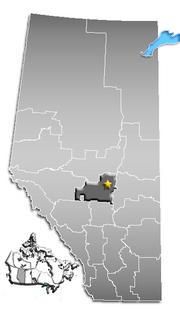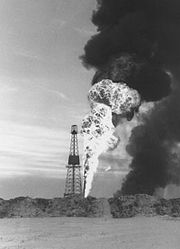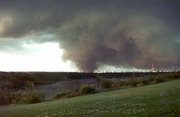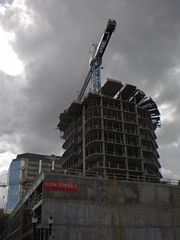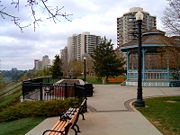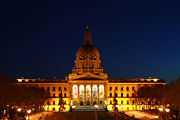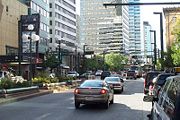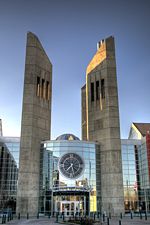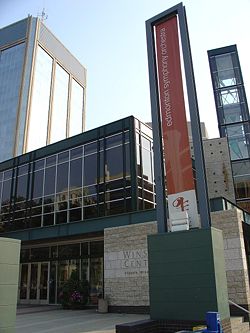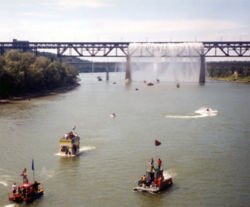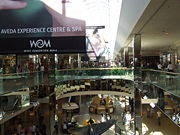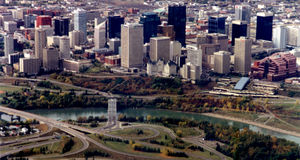Edmonton
2008/9 Schools Wikipedia Selection. Related subjects: North American Geography
| Edmonton | |||
| View of Downtown Edmonton. | |||
|
|||
| Nickname: City of Champions, Festival City-Live all year, Gateway to the North, E-Town, River City, Oil Capital of Canada | |||
| Motto: Industry, Integrity, Progress | |||
| Location of Edmonton within census division number 11, Alberta, Canada. | |||
| Coordinates: | |||
|---|---|---|---|
| Country | |||
| Province | |||
| Region | Edmonton Capital Region | ||
| Census division | 11 | ||
| Established | 1795 | ||
| Incorporated (town) | 1892 | ||
| Incorporated (city) | 1905 | ||
| Government | |||
| - Mayor | Stephen Mandel | ||
| - Governing body | Edmonton City Council | ||
| - Manager | Al Maurer | ||
| - MPs |
List of MPs
|
||
| - MLAs |
List of MLAs
|
||
| Area | |||
| - City | 684.37 km² (264.2 sq mi) | ||
| - Metro | 9,417.88 km² (3,636.3 sq mi) | ||
| Elevation | 668 m (2,192 ft) | ||
| Population (2006) | |||
| - City | 730,372 | ||
| - Density | 1,067.2/km² (2,764/sq mi) | ||
| - Metro | 1,076,103 | ||
| - Metro Density | 109.9/km² (284.6/sq mi) | ||
| - Demonym | Edmontonian | ||
| - Metro rank | 6th | ||
| Time zone | MST ( UTC-7) | ||
| - Summer ( DST) | MDT ( UTC-6) | ||
| Postal code span | T5A to T6Z | ||
| Area code(s) | 780 | ||
| NTS Map | 083H11 | ||
| GNBC Code | IACMP | ||
| Website: City of Edmonton | |||
Edmonton (IPA: /ˈɛdmɨntɨn/) is the capital of the Canadian province of Alberta. The city is located on the North Saskatchewan River in the central region of the province, an area with some of the most fertile farmland on the prairies. It is the second largest city in Alberta after Calgary, with a population of 730,372 (2006), and is the hub of Canada's sixth largest census metropolitan area, with a metropolitan population of 1,076,103 (2006), making it the northernmost North American city with a metropolitan population over one million.
At 684 square kilometres (264 sq mi), the City of Edmonton covers an area larger than Chicago, Philadelphia, Toronto or Montreal. Edmonton has one of the lowest population densities in North America, about 9.4% that of New York City. A resident of Edmonton is known as an Edmontonian.
Edmonton serves as the northern anchor of the Calgary-Edmonton Corridor (one of four regions that together comprise 50% of Canada's population) and is a staging point for large-scale oil sands projects occurring in northern Alberta and large-scale diamond mining operations in the Northwest Territories.
Edmonton is Canada's second most populous provincial capital (after Toronto) and is a cultural, government and educational centre. It plays host to a year round slate of world-class festivals, earning it the title of "The Festival City". It is home to North America's largest mall, West Edmonton Mall, and Canada's largest historic park (Fort Edmonton Park). In 2004, Edmonton celebrated the centennial of its incorporation as a city.
History
Settlement and exploration
The first inhabitants gathered in the area which is now Edmonton around 3,000 BC and perhaps as early as 10,000 BC, when an ice-free corridor opened up as the last ice age ended and timber, water and wildlife became available in the region.
In 1754, Anthony Henday, an explorer working for the Hudson's Bay Company, may have been the first European to enter the Edmonton area. His expeditions across the Canadian Prairies were mainly to seek contact with the aboriginal population for the purpose of establishing fur trade, as competition was fierce between the Hudson's Bay Company and the North West Company. By 1795, Fort Edmonton was established as a major trading post for the Hudson's Bay Company. It was named after Edmonton, London, the home town, of the HBC deputy governor Sir James Winter Lake. In the late nineteenth century, the highly fertile soils surrounding Edmonton helped attract settlers, further establishing Edmonton as a major regional commercial and agricultural centre. Edmonton was also a stopping point for people hoping to cash in on the Klondike Gold Rush in 1897, although the majority of people doing so chose to take a steamship north to the Yukon from Vancouver.
Incorporated as a city in 1904 with a population of 8,350, Edmonton became the capital of Alberta a year later on September 1, 1905.
The war years
During the early 1910s, Edmonton grew very rapidly due to rising speculation in real estate prices. In 1912, Edmonton amalgamated with the city of Strathcona south of the North Saskatchewan River. As a result, the city extended south of the river.
Just prior to World War I, the real estate boom ended suddenly, causing the city's population to decline sharply from over 72,500 in 1914 to under 54,000 only two years later. Recruitment to the Canadian military during the war also contributed to the drop in population. Afterwards, the city was slow to recover in population and economy during the 1920s and 1930s, until World War II.
The first licensed airfield in Canada, Blatchford Field (now Edmonton City Centre Airport), was started in 1929. Pioneering aviators such as Wop May and Max Ward used Blatchford Field as a major base for the distribution of mail, food and medicine to the Canadian North. Hence Edmonton's role as the "Gateway to the North" was strengthened.
World War II saw Edmonton becoming a major base for the construction of the Alaska Highway and the Northwest Staging Route.
The oil boom years
The first major oil discovery in Alberta was made on February 13, 1947 near the town of Leduc to the south of Edmonton. As early as 1914, oil reserves were known to exist in the southern parts of Alberta (see Turner Valley, Alberta), but they produced very little oil compared to those around Edmonton. Additional oil reserves were discovered during the late 1940s and the 1950s near the town of Redwater. Because most of Alberta's oil reserves were concentrated in central and northern Alberta, Edmonton became home to most of Alberta's oil industry.
The subsequent oil boom gave Edmonton new status as the Oil Capital of Canada. During the 1950s, the city increased in population from 149,000 to 269,000. After a relatively calm but still prosperous period in the 1960s, the city's growth took on renewed vigour with high world oil prices, triggered by the 1973 oil crisis and the 1979 Iranian Revolution. The oil boom of the 1970s and 1980s ended abruptly with the sharp decline in oil prices on the international market and the introduction of the National Energy Program in 1981. The population had reached 521,000 that same year. Although the National Energy Program was later scrapped by the federal government in the mid-1980s, the collapse of world oil prices in 1986 and massive government cutbacks kept the city from making a full economic recovery until the late 1990s.
Recent history
In 1981, West Edmonton Mall, which was at the time the world's largest mall, opened. Still the biggest in North America, the mall is one of Alberta's most-visited tourist attractions, and contains an indoor amusement park, a large indoor waterpark, a skating rink, a New Orleans-themed bar district and a luxury hotel in addition to over eight hundred shops and services.
On July 31, 1987, a devastating tornado, ranked as an F4 on the Fujita scale, hit the city and killed twenty-seven people. The storm blew CN rail cars off a bridge crossing the North Saskatchewan River and hit the areas of Beaumont, Mill Woods, Bannerman, Fraser, and the Evergreen Trailer Park. The day became known as "Black Friday". Then-mayor Laurence Decore cited the community's response to the tornado as evidence that Edmonton was a "city of champions", which later became the city's unofficial slogan.
The city entered its current period of economic recovery and prosperity by the late 1990s, helped by a strong recovery in oil prices and further economic diversification. While oil production and refining remains the basis of many jobs in Edmonton, the city's economy has managed to diversify significantly. The downtown core and parts of the inner city, after years of extremely high office vacancy rates and neglect, have recovered to a great degree. It is still undergoing a renaissance of its own, with further new projects underway or about to become reality, and more people choosing to live in or near the downtown core. Because of this renaissance, downtown is becoming very vibrant with the new Art Gallery of Alberta under construction, currently residing in Enterprise Tower during the construction, first office tower in 18 years ( EPCOR Tower Station Lands) now under construction, ICON Towers (which will be the new tallest residential building when completed in 2008-Tower 1, 2009-Tower II) under construction, tons of residential towers under construction and proposed, and The Quarters proposed. Also, just recently, a new urban-format Sobey's grocer opened up downtown on 104 Street, and has since made the area more vibrant, and 104 Street quickly becoming a great shopping district. Along with increased vibrancy on 104, current shopping districts downtown are becoming greater, along with other inner city areas like Whyte Avenue, Glenora, and Westmount. Also due to demand of density, Glenora and Strathearn, two dense inner city neighbourhoods have proposed new high rises. Also in the outskirts, new neighbourhoods are being built (also due to the boom) such as Tamarack or Cameron Heights are being built as well as new power centres such as The Meadows and Windermere. There is also an explosion of warehouses and high tech industry jobs!
This economic prosperity is bringing in large numbers of workers from around Canada. It is forecast that 83,000 new residents will move to Edmonton between 2006 and 2010, twice the rate that city planners had expected. Many of the new workers moving to the city are young men..
Geography and location
Edmonton is located near the geographical centre of the province at an elevation of 668 metres (2,192 ft). The terrain in and around Edmonton is generally flat to gently rolling, with ravines and deep river valleys, such as the North Saskatchewan River valley. Despite the Canadian Rockies lying as close to Edmonton as roughly 220 kilometres to the southwest (only a few hours' drive away), the city is too distant for any of its peaks to be seen from even its tallest buildings.
The North Saskatchewan River bisects the city and originates at the Columbia Icefield in Jasper National Park. It empties, via the Saskatchewan River, Lake Winnipeg, and the Nelson River, into Hudson Bay. It runs from the southwest to the northeast and is fed by numerous creeks throughout the city, such as Mill Creek and Whitemud Creek. This creates numerous ravines, many of which have been incorporated into the urban parkland. Edmonton is situated at the boundary between prairie to the south and boreal forest to the north, in a transitional area known as aspen parkland. However, the aspen parkland in and around Edmonton has long since been heavily altered by farming and other human activities, such as oil and natural gas exploration.
Parkland and environment
Edmonton's river valley constitutes the longest stretch of connected urban parkland in North America, and Edmonton has the highest per capita area of parkland of any Canadian city. The river valley is 22 times larger than New York City's Central Park. The public river valley parks provide a unique urban escape area with park styles ranging from fully serviced urban parks to campsite-like facilities with few amenities. This main 'Ribbon of Green' is supplemented by numerous neighbourhood parks located throughout the city, to give a total of 111 square kilometres (27,400 acres) of parkland. Within the 7,400 hectare (18,000 acre), 25 kilometre (15.5 mi) long river valley park system there are eleven lakes, fourteen ravines, and twenty-two major parks. Most of the city has excellent bike and walking trail connections. These trails are also part of the 235km Waskahegan walking trail.
Edmonton's streets and parklands are also home to one of the largest remaining concentrations of healthy American Elm trees in the world, unaffected by Dutch Elm disease, which has wiped out vast numbers of such trees in Eastern North America. Jack Pine, Lodgepole Pine, White Spruce, White Birch, Aspen, Green Ash, Basswood, various poplars and willows, and Manitoba Maple are also abundant; Bur Oak is increasingly popular. Introduced tree species include Blue Spruce, Norway Maple, Red Oak, Sugar Maple, Common Horse-chestnut, McIntosh Apple, and Evans Cherry. Three walnut species -- Butternut, Manchurian Walnut and Black Walnut -- have survived in Edmonton.
Several golf courses, both public and private, are also located in the river valley. The long summer daylight hours of this northern city provide for extended play well into the evening. Golf courses and the park system become a winter recreation area during this season. Cross-country skiing and skating are popular during the long winter. Four downhill ski slopes are located in the river valley as well, two within the city and two immediately outside.
The City of Edmonton has named five parks in its River Valley Parks System in honour of each of " The Famous Five".
Neighbourhoods
Edmonton has numerous distinct neighbourhoods.
The downtown core consists of the Commercial Core, Arts District, Rice Howard Way Pedestrian Mall, MacKay Avenue, Jasper-West, Warehouse District and Government Precinct (a.k.a. Grandin neighbourhood).
Radiating from the core are many inner city neighbourhoods such as Oliver, Glenora, Westmount, Queen Mary Park, Inglewood, Central McDougall, Boyle Street, McCauley, Alberta Avenue and Norwood on the north side of the river, while Windsor Park, Garneau, Strathcona, Bonnie Doon, and Strathearn line the south side of the river. Several communities survived attempts by the municipal governments of the 1970s to rid the valley proper of all residents: these are Riverdale, Rossdale, Walterdale, and Cloverdale.
As with any city of its size, the inner communities give way to a collection of suburbs, generally classified as being outside the inner ring road and in extreme cases, outside of Anthony Henday Drive. One of the most well known communities within Anthony Henday Drive is Mill Woods, which is home to approximately 100,000 residents. Often, it is incorrectly referred to as "Millwoods" due to a typographical mistake on street signs, dating back to the neighbourhood's inception. If Mill Woods were a separate municipality, it would be Alberta's third largest city after Calgary and Edmonton.
Other communities within the boundaries of the Anthony Henday on the south side of Edmonton include Riverbend, (situated between the North Saskatchewan River and Whitemud Creek), Aspen Gardens, Westbrook Estates, Royal Gardens, Sweet Grass, Blue Quill, Blue Quill Estates, Greenfield, Lansdowne and Grandview Estates, with their main transportation hub as Southgate Transit Centre. Surrounding the new Century Park development are communities such as Yellowbird and Twin Brooks. Several new neighbourhoods are currently in formative stages in the South and Southwest, such as MacEwan, Terwillegar, Southbrook, and Rutherford.
Several transit-oriented developments (TOD) have begun to appear along the LRT line at Clareview with future developments planned at Belvedere (part of the Old Town Fort Road Redevelopment Project). Another TOD called Century Park is already under construction at the site of what was once Heritage Mall (currently under demolition) at the southern end of the future South LRT line. Century Park will eventually house up to 5,000 residents.
Climate
Edmonton has a northern continental climate with extreme seasonal temperatures, although the city has milder winters than either Regina or Winnipeg, which are both located at a more southerly latitude. It has mild summers and chilly winters, with the average daily temperatures ranging from -11.7° C (10.9° F) in January to 17°C (62°F) in July. Annually, temperatures exceed 30°C (86°F) on an average of three days [but can occur often anytime from late May and early September] and fall below −20°C (−4°F) on an average of twenty-eight days. The highest temperature recorded in Edmonton was 34.5°C (94.1°F) on August 5, 1998. Some areas, however, such as the City of St Albert and Sherwood Park recorded temperatures of 37.7°C (99.9°F) on July 22, 2006. The coldest temperature was −49.4°C (−56.9°F), recorded on January 19 and 21, 1886.. 2006 was a particularly warm year for Edmonton, as temperatures reached 29°C (84.2°F) or higher more than twenty times during the year, from as early as Mid-May and again in early September. Typically, summer lasts from late June until late August, and the humidity is seldom uncomfortably high. Winter lasts from November to March and varies greatly in length and severity. Spring and autumn are both short and highly variable.
Edmonton has a fairly dry climate. On average, Edmonton receives 476 mm (18.78 in) of precipitation and 123.5 cm (48.6 in) of snowfall per annum. Precipitation is heaviest in the late spring, summer, and early autumn. The wettest month is July, while the driest months are February, March, October, and November. In July, the mean precipitation is 92 mm (3.6 in). Extremes do occur such as the 114 mm of rainfall that fell on July 31, 1953. Summer thunderstorms can be frequent and occasionally severe enough to produce large hail, damaging winds, funnel clouds and even tornadoes. However, tornadoes near Edmonton are far weaker and short-lived compared to their counterparts farther south. Tornadoes as powerful as the F4 tornado which struck Edmonton on July 31, 1987, killing twenty-seven, are very rare.
A massive cluster of thunderstorms occurred on July 11, 2004, with large hail and over 100 mm (4 in) of rain reported within the space of an hour in many places. This "1-in-200 year event" flooded major intersections and underpasses as well as damaging both residential and commercial properties. The storm caused extensive damage to West Edmonton Mall. The roof collapsed under the weight of the rainwater, causing water to drain onto the mall's indoor ice rink. As a result, the mall was forced to undergo an evacuation as a precautionary measure.
| Weather averages for Edmonton (City Centre Airport) | |||||||||||||
|---|---|---|---|---|---|---|---|---|---|---|---|---|---|
| Month | Jan | Feb | Mar | Apr | May | Jun | Jul | Aug | Sep | Oct | Nov | Dec | Year |
| Average high °C | -7.3 | -3.6 | 2.1 | 11.3 | 17.6 | 21.0 | 22.8 | 22.1 | 16.8 | 10.9 | 0.0 | -5.4 | 9.0 |
| Average low °C | -16.0 | -13.1 | -7.3 | -0.3 | 5.7 | 10.0 | 12.1 | 11.1 | 5.8 | 0.3 | -8.2 | -13.9 | -1.2 |
| Precipitation mm | 22.5 | 14.6 | 16.6 | 26.0 | 49.0 | 87.1 | 91.7 | 69.0 | 43.7 | 17.9 | 17.9 | 20.9 | 476.9 |
| Average high °F | 18.9 | 25.5 | 35.8 | 52.3 | 63.7 | 69.9 | 73.0 | 71.8 | 62.2 | 51.6 | 32.0 | 22.3 | 48.2 |
| Average low °F | 3.2 | 8.4 | 18.9 | 31.5 | 42.3 | 50.0 | 53.8 | 52.0 | 42.4 | 32.5 | 17.2 | 7.0 | 29.8 |
| Precipitation inches | 0.89 | 0.57 | 0.65 | 1.02 | 1.93 | 3.43 | 3.61 | 2.72 | 1.72 | 0.70 | 0.70 | 0.82 | 18.78 |
| Source: Environment Canada Jan 2007 | |||||||||||||
Edmonton is the most northerly major city in North America with a metro population of over one million. It is at the same latitude as Hamburg, Germany and Liverpool, England. At the summer solstice, Edmonton receives seventeen hours and six minutes of daylight, with twilight extending well beyond that. Edmonton receives 2,289 hours of sunshine per year, and is one of Canada's sunniest cities.
Economy
Edmonton is the major economic centre for northern and central Alberta and a major centre for the oil and gas industry. In its Autumn 2007 Metropolitan Outlook, the Conference Board of Canada forecast that Edmonton's GDP for 2007 will be $44.1 billion (2007 dollars), a 3.6% increase over 2006. The Edmonton Economic Development Corporation estimated that as of January 2005 the total value of major projects under construction in northern Alberta was $81.5 billion, with $18.2 billion occurring within Greater Edmonton.
Edmonton traditionally has been a hub for Albertan petrochemical industries, earning it the nickname "Oil Capital of Canada" in the 1940s. Supply and service industries drive the energy extraction engine while research develops new technologies and supports expanded value-added processing of Alberta's massive oil, gas and oil sands reserves. These are reported to be the second largest in the world after Saudi Arabia.
Despite the apparent focus on oil and gas, Edmonton's economy is now the second most diverse in Canada. Major industrial sectors include a strong technology sector anchored by major employers such as IBM, Telus, Intuit Canada, Canadian Western Bank, BioWare, Matrikon, General Electric and Stantec. The associated biotech sector, with companies such as CV Technologies, has recently seen employment growth of 37%.
Much of the growth in technology sectors is due to Edmonton's reputation as one of Canada’s premiere research and education centres. Research initiatives are anchored by educational institutions such as the University of Alberta as well as government initiatives underway at the Alberta Research Council and Edmonton Research Park. Recently the National Institute for Nanotechnology was constructed on the University of Alberta campus.
During the 1970's and 1980's, Edmonton started to become a major financial centre with both regional offices of Canada's major banks and locally based institutions opening. However, the turmoil of the late 1980s economy radically changed the situation. Locally based operations such as Principal Trust and Canadian Commercial Bank would fail and regional offices were moved to Calgary. The 1990s saw a solidification of the economy and now Edmonton is home of Canadian Western Bank, the only publicly traded Schedule I chartered bank headquarters west of Toronto. Other major financial centres include ATB Financial, Servus Credit Union (formerly Capital City Savings), TD Canada Trust, Manulife.
Edmonton has been the birth place of several companies which have grown to international stature such as PCL Construction, and Stantec Inc.. The local retail market has also seen the creation of many successful store concepts such as The Brick, Katz Group, AutoCanada, Boston Pizza, Pizza 73, Liquor Stores, Liquor Barn, Planet Organic, Empire Design, Running Room, Booster Juice, Earl's, Fountain Tire and XS Cargo.
The geographical location of Edmonton has made it an ideal spot for distribution and logistics. CN Rail's North American operational facility is located in the city as well as a major intermodal facility that handles all incoming freight from the port of Prince Rupert in British Columbia.
Edmonton was judged to have the “best economic potential” of any North American city by the Financial Times publication, Foreign Direct Investment (FDI) magazine. In a 2007 study, FDI placed Edmonton immediately ahead of Mississauga, Charlotte, Tijuana, and Calgary among cities with populations between 500,000 and 2 million. Edmonton's economic potential, expanding infrastructure, human resources, cost effectiveness and high standard of living place it in the No. 4 spot on FDI’s list of top-10 North American large cities. The survey also named Edmonton in the top-five large North American cities for business development and investment promotion. Edmonton is known for its exceptional environmental stewardship, strong life-science sector, and burgeoning high-tech industry economy.
Demographics
|
||||||||||||||||||||||||||||||||||||||||||
|
According to the mid-2006 census, there were 730,372 residents within the city of Edmonton proper, compared to 3,290,350 for all of Alberta. The total population of the CMA ( Census Metropolitan Area) was 1,034,945.
In the five years between 2001 and 2006, the population of the city of Edmonton proper grew by 9.6%, compared with an increase of 10.4% for Edmonton CMA, and 10.6% for Alberta as a whole. The population density of the city of Edmonton proper averaged 1,067.2 people per square kilometre (2,764/sq mi), compared with an average of 5.1 people per square kilometre (13.2/sq mi), for Alberta altogether.
In mid-2001, 11.7% of Edmonton's population were of retirement age (65 and over for males and females) compared with 13.2% in Canada. The median age is 35.3 years of age compared to 37.6 years of age for all of Canada. Also, according to the 2001 census, 50.5% of the population within the city of Edmonton proper is female, while 49.5% is male. Children under five accounted for approximately 5.8% of the resident population of Edmonton. This compares with 6.2% in Alberta, and almost 5.6% for Canada overall.
In 2006, people of European ethnicities formed the largest cluster of ethnic groups in Edmonton, mostly of English, Scottish, German, Irish, Ukrainian and French origins. According to the 2006 census, the city of Edmonton was 71.8% White and 5.3% Aboriginal, while Visible Minorities accounted for 22.9% of the population.
Infrastructure
- Transportation
Edmonton is a major transportation gateway to northern Alberta and northern Canada. There are two airports serving the city, Edmonton City Centre Airport and Edmonton International Airport, of which the latter is the largest. The Edmonton International Airport has passengers flying to destinations in the United States, Europe, Mexico, and the Caribbean, along with charters to Japan. The Edmonton City Centre Airport is a general aviation facility since air services consolidation in 1995 and the only airport located within the city limits. It is home to a variety of aviation companies with key markets in Northern Alberta. Interurban passenger rail service is operated by VIA Rail to Jasper National Park, Saskatchewan, and British Columbia. Edmonton serves as a major transportation hub for Canadian National Railway, whose North American operations management centre is located at their Edmonton offices.
With direct air distances from Edmonton to places such as New Delhi in Asia and London in Europe being shorter than to other main airports in Western North America, Edmonton Airports is working to establish a major container shipping hub called Port Alberta.
A largely gridded street system forms most of Edmonton's street and road network. The address system is mostly numbered, with streets running south to north and avenues running east to west. In built-up areas built since the 1950s, local streets and major roadways generally do not conform to the grid system. Major roadways include Yellowhead Trail and Whitemud Drive, and the city is connected to other communities elsewhere in Alberta, B.C., and Saskatchewan via the Yellowhead Highway to the west and east, and the Queen Elizabeth II Highway to the south.
The Edmonton Transit System is the city's main public transit agency, operating a light rail transit (LRT) line as well as a large fleet of buses and trolley buses. Scheduled LRT began on April 23, 1978, with five extensions of the single line completed since. The original Edmonton line is considered to be the first "modern" light rail line in North America (i.e. built from scratch, rather than being an upgrade of an old system). It introduced the use of German-designed rolling stock that subsequently became the standard light rail vehicle of the United States. The Edmonton "proof of payment" fare collection system adopted in 1980—modelled after European ticket systems—became the North American transit industry's preferred approach for subsequent light rail projects. Currently the City of Edmonton is working on the South LRT Extension, which will see trains travelling to Century Park, located at 23 Avenue and 111 Street by the end of 2009, while making an additional stop at Southgate Centre. To facilitate this change, ETS is constructing a new transit centre on 111 Street across from Southgate.
There is an extensive multi-use trail system for bicycles and pedestrians throughout the city; however, most of this is within the river valley parkland system.
- Waste disposal
The Edmonton Composting Facility, the largest stainless steel building in North America. The facility is the largest of its type in the world.
In the next few years, the city anticipates it will divert more than 80% of the city's household waste from entering the landfills. Among the innovative uses for the city's waste includes a Christmas tree recycling program. The trees are collected each January and put through a wood chipper. This material is used to insulate the fields of developing compost. In addition, the wood chips absorb much of the odour produced by the compost, by providing a biological element onto which the odours can attach themselves.
Together, the Waste Management Centre and Wastewater Treatment plant are known as the Edmonton Waste Management Centre of Excellence. Research partners include the University of Alberta, Alberta Research Council, Northern Alberta Institute of Technology, and Olds College.
- Electricity and water distribution systems
Edmonton's first power company established itself in 1891 and installed street lights along the city's main avenue, Jasper Avenue. The power company was bought by the Town of Edmonton in 1902 and remains under municipal ownership today as EPCOR. Also in charge of water treatment, in 2002, EPCOR installed the world's largest ultraviolet (UV) water treatment or Ultraviolet disinfection system at its E.L. Smith Water Treatment Plant.
- Health care
There are four main hospitals serving Edmonton: The University of Alberta Hospital, The Royal Alexandra Hospital, The Misercordia Hospital and The Grey Nuns Hospital. Other area hospitals include the Sturgeon Community Hospital in St. Albert, the Leduc Community Hospital in Leduc, the Westview Health Centre in Stony Plain, and the Fort Saskatchewan Health Centre in Fort Saskatchewan. Dedicated psychiatric care is also provided at the Alberta Hospital. All hospitals are under the administration of the Capital Health Authority although the Misercordia and the Grey Nuns are run separately by the Caritas Health Group.
Education
Post-secondary
Edmonton has become one of Canada's major educational centres with more than 60,000 full time post-secondary students spread over several institutions and campuses (total enrolment between the schools is as high as 170,000, which includes students enrolled in multiple institutions).
The University of Alberta (known colloquially as the "U of A"), whose main campus is situated on the south side of Edmonton's river valley, is a board-governed, public institution with annual revenue of one billion dollars. 35,000 students are served in more than 200 undergraduate programs and 170 graduate programs. Main campus consists of more than ninety buildings on 890,000 square metres (220 acres) of land, with buildings dating back to the university's establishment in 1908. It is also home to Canada's second largest research library which ranks first in volumes per student with over 10 million (in 2005) and subscriptions to 13,000 full-text electronic journals and 500 electronic databases.
Other universities within the borders of Edmonton include Athabasca University, Concordia University College of Alberta, the King's University College, Taylor University College and Seminary, and the Edmonton campus of the University of Lethbridge.
Other Edmonton post-secondary institutions include Grant MacEwan College, which enrolls 40,791 students in programs offering career diplomas, university transfers and bachelor degrees the Northern Alberta Institute of Technology (NAIT), with 48,500 students enrolled in 190 technical, vocational and apprenticeship programs and NorQuest College, with 11,300 students, specializing in short courses in skills and academic upgrading.
Edmonton is also home to Antarctic Institute of Canada.
K-12
Edmonton has three publicly funded school boards (districts), who provide kindergarten and grades one through twelve. The vast majority of students attend schools in the two large English language boards: Edmonton Public Schools and the separate Catholic school Edmonton Catholic School District. Also, since 1994, the francophone minority community has had their own school board based in Edmonton, the North-Central Francophone School Authority, which includes surrounding communities. Most recently the city has seen a small number of public charter schools open, independent of any board. All three school boards and public charter schools are funded through provincial grants and property taxes.
Some private schools exist as well. Included are the Edmonton Academy and Tempo School. The Edmonton Society for Christian Education used to be a private school, however they became part of Edmonton Public Schools.
Both the Edmonton Public Schools and the Edmonton Catholic School District provide support and resources for those wishing to home school their children.
City life
Nightlife
There are several key concentrations of nightlife in the city of Edmonton. The most popular is the Whyte Avenue (82nd Avenue) strip, concentrated between 109 Street and 99 Street. It has the highest concentration of heritage buildings in Edmonton. Once the heart of the town of Strathcona (annexed by Edmonton on February 1, 1912), it fell into disrepair during the middle of the twentieth century. Beginning in the 1970s, a concentrated effort to revive the area through the establishment of a Business Revitalization Zone has produced an area rich with restored historical buildings and pleasant streetscapes. Its proximity to the University of Alberta has led to a high concentration of establishments ranging from restaurants and pubs to trendy clubs while hosting a wide variety of shops during the day. This area also contains two independent movie theatres: the Garneau and Princess theatres, as well as several live theatre, music and comedy venues.
Downtown Edmonton has undergone a continual process of renewal and unprecedented growth since the mid 1990s. Many buildings were demolished during the oil boom starting in the 1960s and continuing into the 1980s to make way for office towers. As such, there have always been numerous pub-type establishments such as The Rose and Crown, Sherlock Holmes' and Elephant & Castle as well as many hotel lounges and restaurants. The past decade, has seen a strong resurgence in more mainstream venues. Edmonton also has a high demand for pub crawl tours in the city. Various clubs such as the New City Suburbs, "OilCity Roadhouse", "The Bank", and Halo are also to be found along Edmonton's main street, Jasper Avenue. The Edmonton City Centre mall also houses an Empire Theatres movie theatre, featuring ten screens. The non-profit Metro Cinema shows a variety of alternative or otherwise unreleased films every week.
West Edmonton Mall holds several after hour establishments in addition to its many stores and attractions. Bourbon Street has numerous eating establishments and clubs and casinos can also be found within the complex. Scotiabank Theatre (formerly known as SilverCity), at the west end of the mall, is a theatre which features twelve screens and an IMAX.
Culture
Many events are anchored in the downtown Arts District, centred around the newly renovated Churchill Square (named in honour of Sir Winston Churchill).
- The Francis Winspear Centre for Music was opened in 1997 after years of planning and fundraising. Described as one of the most acoustically perfect concert halls in Canada, it is home to the Edmonton Symphony Orchestra and hosts a wide variety of shows every year. It seats 1,932 patrons and houses the $3 million Davis Concert Organ, the largest concert organ in Canada. An interesting aspect of the hall's design is its separation into acoustically separate areas each of which are insulated from each other through acoustical barriers built into the structure. Patrons and artists can see these in the form of double-door "sound locks".
- Across 102nd Avenue is the Citadel Theatre, so named after the Salvation Army Citadel in which Joe Shoctor first started the Citadel Theatre company in 1965. It is now one of the largest theatre complexes in Canada with five halls each specializing in different kinds of productions. For instance, the Maclab Theatre features a thrust stage surrounded by a U-shaped seating arrangement, while the Shoctor Theatre is a traditional stage setup.
- On the University of Alberta grounds is the 2534-seat Northern Alberta Jubilee Auditorium, which recently reopened after being out of commission for a year during heavy renovations carried out as part of the province's centennial celebrations. Both it and its southern twin in Calgary were constructed in 1955 for the province's silver jubilee and have played host to many concerts, musicals, and ballets. The Edmonton Opera uses the Jubilee as its base of operations. On the front of the building is a quote from Suetonius' Life of Augustus: "He found a city built of brick—left it built of marble."
- Old Strathcona is home to the Theatre District, which holds the Transalta Arts Barns (headquarters of the Edmonton International Fringe Festival), The Walterdale Playhouse, Catalyst Theatre, and the Varscona Theatre (base of operations for several theatre companies, including Teatro la Quindicina, Shadow Theatre, Rapid Fire Theatre, Die-Nasty, and Oh Susanna!). Edmonton was named cultural capital of Canada in 2007.
Museums and galleries
There are also over seventy museums in Edmonton of ranging sizes. The largest is the Royal Alberta Museum (formerly the Provincial Museum of Alberta until renamed by Queen Elizabeth II during her 2005 visit) which houses over 10 million objects in its collection. The museum showcases the culture and practices of the diverse aboriginal tribes of the region. The main building, located on the river valley west of downtown in Glenora, was opened in 1967 and is now in the early stages of large-scale redevelopment.
The Telus World of Science is located in the Woodcroft district. It opened in 1984 but has been expanded several times since then. It contains 5 permanent galleries, plus 1 for temporary exhibits, an IMAX theatre, a planetarium, an observatory and an amateur radio station.
The Alberta Aviation Museum is at the City Centre Airport, in a hangar that was built for the British Commonwealth Air Training Plan. Its collection includes both civilian and military aircraft, of which the largest are a Boeing 737 and two CF-101 Voodoos. Every summer it holds a small airshow, featuring modern fighter aircraft that fly in from Maple Flag for the event.
The Alberta Railway Museum is located in the extreme north end of the city. It contains a variety of locomotives and railroad cars from different periods, and includes a working steam locomotive. Since most of its exhibits are outdoors, it is only open between Victoria Day and Labour Day.
The Art Gallery of Alberta was the city's largest single gallery. Housed in an inconspicuous production of 1970s architecture, the AGA collection had over 5,000 pieces of art. The Art Gallery was demolished in July 2007, for construction of a new facility designed by Randall Stout estimated to cost over $88 million dollars. The amount that Edmonton City Council has donated towards the construction was met with some controversy. Independent galleries can be found throughout the city, especially along the 124th Street corridor.
The University of Alberta operates its own internal Museums and Collections service.
Festivals
Edmonton plays host to several large festivals each year, hence its local nickname as "The Festival City". Downtown Edmonton and Churchill Square host numerous festivals each summer. The Works Art & Design Festival, which takes place from late June to early July, showcases Canadian and international art and design from well-know, award-winning artists, as well as emerging and student artists. The Edmonton International Street Performer's Festival takes place in mid-July and showcases street performance artists from around the world.
Edmonton's main summer festival is Capital Ex (formerly Klondike Days). Klondike Days (or K-Days) was originally an annual fair and exhibition which eventually adopted a gold rush theme. In early 2006, it was decided that the festival would be renamed "The Capital City Exhibition" ("Capital Ex"). Activities include chuckwagon races, carnival rides and fairways, music, trade shows and daily fireworks. Since 1960, the Sourdough Raft Races have also been a popular event. Later in November, Edmonton plays host to the Canadian Finals Rodeo and Farmfair. This is a significant event in Canada's rodeo circuit and second only to the National Finals Rodeo in Las Vegas in prestige.
The Edmonton International Fringe Festival, which takes place in mid-August, is the largest Fringe Theatre Festival in North America, and second only to the Edinburgh Fringe festival in the world. In August, Edmonton is also host to the Edmonton Folk Music Festival, one of the most successful and popular folk music festivals in North America. Another major summer festival is the Edmonton Heritage Festival which is an ethnocultural festival that takes place in Hawrelak Park on the Heritage Day long weekend.
Many other festivals occur such as the Free Will Shakespeare Festival, the Boat Festival, Whyte Avenue Art Walk, and the Edmonton International Film Festival.
Shopping
Edmonton is home to several shopping malls, including West Edmonton Mall, which was the world's largest mall, and is now North America's largest. Other malls include Bonnie Doon Shopping Centre, Edmonton City Centre (formerly Eaton Centre), Westmount Centre, Southgate Centre (currently undergoing renovations), Kingsway Garden Mall, Northgate Centre, Abbotsfield Mall and Londonderry Mall.
Edmonton also has many big-box shopping centres and power centres. Some of the major ones include: South Edmonton Common (North America's largest open air retail development), Terra Losa Shopping Centre, Southpark Centre, The Meadows and North Town Centre. As well, Windermere will be a new shopping centre to be built in 2008.
Although there are many suburban outlets in Edmonton, there are many urban shopping areas. Whyte Avenue, which is on the south side of the river near the university, is one of the most popular, with many urban retailers. It is the centre of the former Strathcona town.
Another urban centre is 124 Street/High Street that is an emerging shopping district. It holds such retailers as Ginger, Dwell Modern, Light Form, Matahari, and McEtherans. In the downtown core, there are a few shopping areas such as 104 Street (4th st.), which is an urban-style shopping area/district. It holds certain urban trendy shops and restaurants like: Sobeys: Ready to Serve, 29 Armstrong, Eye Group, Blue Plate, Tzin, Ric's, as well as many galleries. Other shopping areas in downtown Edmonton are: The Arts District, Edmonton City Centre, and Jasper Avenue.
There are also several farmers' markets in Edmonton. There is the Strathcona Farmers Market around Whyte Avenue, The Callingwood Farmer Market at the Martketplace at Callingwood, and City Market which is an urban farmer's market on 104 Street downtown.
Sports and recreation
Edmonton has a proud heritage of very successful sports teams including the Edmonton Grads, Edmonton Eskimos, Edmonton Trappers, Edmonton Oil Kings, and Edmonton Oilers. The primary professional sports facilities are the Commonwealth Stadium, Telus Field and Rexall Place.
Numerous minor-league teams in the City include the Edmonton Cracker-Cats, the city's thirteenth baseball franchise since 1884. Local rugby players compete in the Rugby Canada Super League with the Edmonton Gold. Also, the city hosts the Edmonton Rush national lacrosse team, which plays out of Rexall Place
In addition to the minor-league teams, Edmonton also has very successful University-level sports teams including the U of A Golden Bears, the U of A Pandas, NAIT Ooks, and Grant MacEwan Griffins.
Edmonton hosted the 1978 Commonwealth Games, the 1983 World University Games ( Universiade), the 2001 World Championships in Athletics, and the 2005 World Master Games. In 2006, it played host to the Women's Rugby World Cup. In the summer of 2007, Edmonton hosted the Under 20 Fifa World Cup which is the third largest sporting event in the world as well as the CN Canadian Womens Open.
Edmonton has a circuit on the Indy Racing League known as the Edmonton Indy (formerly the Grand Prix of Edmonton). In addition, Castrol Raceway brings sprint cars and a national IHRA event to their facility next to Edmonton International Airport.
| Club | League | Venue | Established | Championships |
| Edmonton Eskimos | Canadian Football League | Commonwealth Stadium | 1949 | 13 |
| Edmonton Oilers | National Hockey League | Rexall Place | 1972 | 5 |
| Edmonton Cracker Cats | Golden Baseball League | Telus Field | 2005 | 0 |
| Edmonton Rush | National Lacrosse League | Rexall Place | 2005 | 0 |
| Edmonton Oil Kings | Western Hockey League | Rexall Place | 2007 | 0 |
| Edmonton Chill | International Basketball League | Grant MacEwan College | 2008 | 0 |
| Edmonton Drillers | Canadian Major Indoor Soccer League | Servus Place (St. Albert) | 2008 | 1 |
| Edmonton Seahawks | Alberta Football League | Clarke Stadium | 2006 | 0 |
| Edmonton Stallions | Alberta Football League | Foote Field | 2003 | 1 |
Metropolitan area
Edmonton is at the centre of a metropolitan area that includes twenty-five independent municipalities either adjacent to Edmonton's city limits or within several kilometres of it. Larger communities include Sherwood Park (part of the Specialized Municipality of Strathcona County), St. Albert, Spruce Grove, Stony Plain, Fort Saskatchewan, Leduc, Nisku (major industrial area in Leduc County), and the towns of Beaumont, Devon and Morinville. This large scale fragmentation has played a role in the development of the Edmonton region. Although several attempts have been made by the City of Edmonton to annex surrounding municipalities, no amalgamation has of yet been approved by the provincial government since Edmonton absorbed the town of Beverly in 1961.
Notable people
- Tommy Banks, jazz musician, Canadian Senator
- Chris Benoit, Professional Wrestler ( WWE, WCW, ECW, New Japan)
- John Bucyk, NHL hockey player
- Terry Chen, film actor
- Rae Dawn Chong, film actor
- Tommy Chong, film actor and comedian
- Bernard Ebbers, WorldCom co-founder
- Nathan Fillion, film actor
- Michael J. Fox, film actor
- Robert Goulet, film actor
- Jay Bouwmeester NHL hockey player
- Scott Niedermayer NHL hockey player
- Erik Christensen NHL hockey player
- Randy Gregg, NHL hockey player
- Jill Hennessy, film actor
- Arthur Hiller, film director
- Kelly Hrudey, NHL commentator
- Jarome Iginla, NHL hockey player
- W.P. Kinsella, film author
- Marshall McLuhan, philosopher
- Mark Messier, NHL hockey player
- Leslie Nielsen, film actor
- Robert Young Pelton, author
- Dion Phaneuf, NHL hockey player
- Doug Pruden, athlete
- John "Red" Pollard, jockey
- Catherine Mary Stewart, film actor
- Ryan Stock, T.V. Circus stunt man
- Max Ward, aviator
- Kenneth Welsh, film actor
- Greg Zeschuk, co-founder, BioWare Corp.
- Ray Muzyka, co-founder, BioWare Corp.
- Kreesha Turner, singer/song-writer
Military
Edmonton is home to 1 Canadian Mechanized Brigade Group (1 CMBG), the Regular Force army brigade group of Land Force Western Area of the Canadian Army. Units in 1 CMBG include Lord Strathcona's Horse (Royal Canadians), 1 Combat Engineer Regiment, two of the three regular force battalions of Princess Patricia's Canadian Light Infantry, and various headquarters, service and support elements. Although not part of 1 CMBG, 408 Tactical Helicopter Squadron and 1 Field Ambulance are co-located with the brigade group. All of these units are located at Lancaster Park, immediately north of the city. From 1943 it was a major air force base . In 1996, the aviation units were transferred to CFB Cold Lake.
The Canadian Airborne Training Centre had been located in the city in the 1980s. The move of 1CMBG and component units from Calgary occurred in 1996 in what was described as a "cost-saving" measure. The brigade had existed in Calgary since the 1950s, and Lord Strathcona's Horse had traditionally been a Calgary garrison unit dating back before the First World War.
Edmonton also has a large army reserve element from 41 Canadian Brigade Group (41 CBG) including the The Loyal Edmonton Regiment (4th Battalion, Princess Patricia's Canadian Light Infantry), 8 Field Engineer Regiment, and HQ Squadron, 20th Field Artillery Regiment, and B Squadron of The South Alberta Light Horse, one of Alberta's oldest army reserve units. Despite being far from Canada's coasts, Edmonton is also the home of HMCS Nonsuch, a Naval Reserve division.
There are numerous cadet corps of the different elements (Sea, Army and Air Force) within Edmonton as well.
The Edmonton Garrison is currently located in the north end of Edmonton, in an area known as Lancaster Park
Religion
Edmonton holds the following religious offices:
- The archbishop responsible for Roman Catholic institutions in central Alberta between the Saskatchewan and British Columbia borders.
- The archbishop responsible for Ukrainian Catholic Church in Alberta.
- The archbishop responsible for Ukrainian Orthodox Church of Canada in all of Western Canada.
- The bishop responsible for Eastern Rite Orthodox Churches in North America.
- The bishop responsible for Anglican institutions in central Alberta between the Saskatchewan and British Columbia borders.
One of Alberta's two Baha'i Centres is located in Edmonton, the other centre is situated in Sylvan Lake, Alberta.
The first mosque established in North America, the Al-Rashid Mosque founded by Abdullah Yusuf Ali, is situated in Edmonton.
Edmonton also hosts a Maronite Catholic church, on 76th Avenue/98th Street with services in English (on Saturdays) and Arabic (on Sundays).
Another sign of the Lebanese community's visibility is the existence of a Druze Community Centre on the north side of the city.
The Edmonton Alberta Temple of the Church of Jesus Christ of Latter-day Saints was dedicated on December 11, 1999.
The Hindu Community in Edmonton is served by the Hindu Society of Alberta (North Indian Temple) and Maha Gahapathy Society of Alberta (South Indian Temple).
Sister cities
Edmonton is an official sister city of several cities worldwide:
 Hull, Quebec (now a part of Gatineau, Quebec) (1967)
Hull, Quebec (now a part of Gatineau, Quebec) (1967) Harbin, Heilongjiang Province, China (1985)
Harbin, Heilongjiang Province, China (1985) Nashville, Tennessee, United States (1990)
Nashville, Tennessee, United States (1990) Wonju, Gangwon Province, South Korea (1998)
Wonju, Gangwon Province, South Korea (1998)



